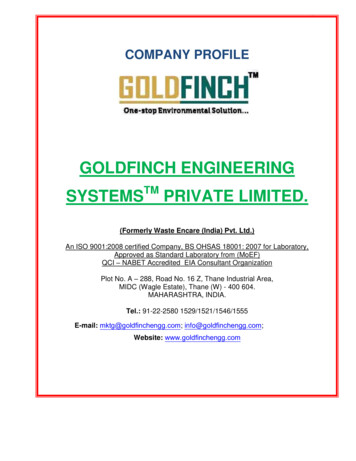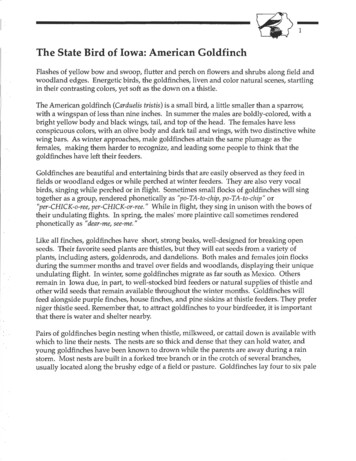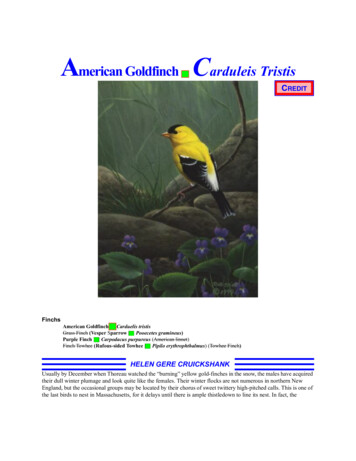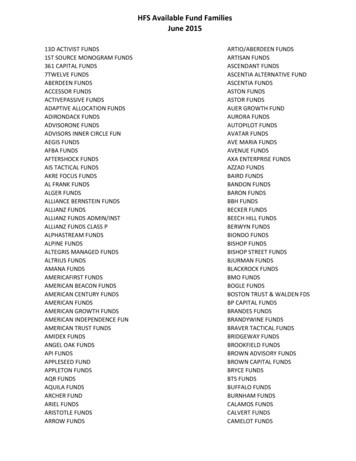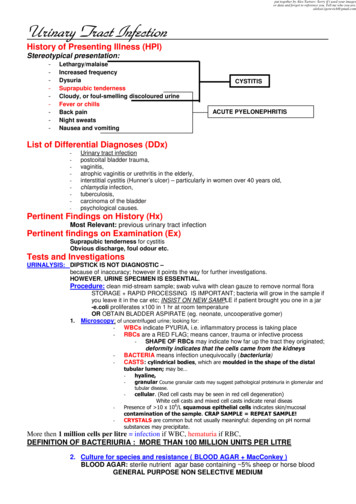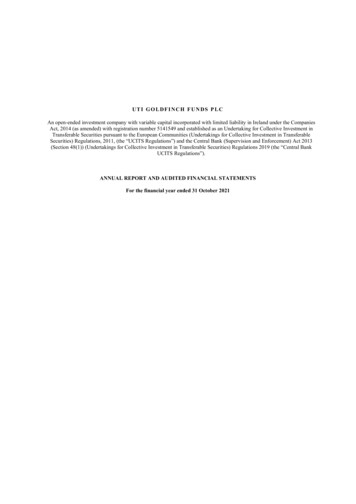
Transcription
UTI GOLDFINCH FUNDS PLCAn open-ended investment company with variable capital incorporated with limited liability in Ireland under the CompaniesAct, 2014 (as amended) with registration number 5141549 and established as an Undertaking for Collective Investment inTransferable Securities pursuant to the European Communities (Undertakings for Collective Investment in TransferableSecurities) Regulations, 2011, (the “UCITS Regulations”) and the Central Bank (Supervision and Enforcement) Act 2013(Section 48(1)) (Undertakings for Collective Investment in Transferable Securities) Regulations 2019 (the “Central BankUCITS Regulations”).ANNUAL REPORT AND AUDITED FINANCIAL STATEMENTSFor the financial year ended 31 October 2021
UTI GOLDFINCH FUNDS PLCContentsGeneral Information1Background to the Company2–3Investment Manager’s Report4–9Directors’ ReportReport of the Depositary to the Shareholders10 – 1213Independent Auditor’s Report14 – 19Statement of Financial Position20 – 21Statement of Comprehensive Income22 – 23Statement of Changes in Net Assets Attributable to Holders of Redeemable Participating Shares24 – 25Statement of Cash Flows26 – 27Schedule of Investments28 – 31Notes to the Financial Statements32 – 50AppendicesAppendix 1 - Supplementary Information (unaudited)51Appendix 2 - Disclosure of Remuneration (unaudited)52Appendix 3 – Securities Financing Transactions Regulation (unaudited)53Appendix 4 – Sustainable Finance Disclosure Regulation (unaudited)53Appendix 5 - Schedule of Portfolio Changes (unaudited)51 – 55
UTI GOLDFINCH FUNDS PLCGeneral InformationBoard of DirectorsInvestment AdvisorPraveen Jagwani* (Indian)Samantha McConnell (Irish)Simon McDowell** (Irish)(1)All of the Directors are non-executive.UTI Asset Management Company LimitedUTI - Tower, “Gn” BlockBandra Kurla ComplexMumbai - 400051IndiaRegistered OfficeInvestment Manager and Distributor33 Sir John Rogerson’s QuayDublin 2IrelandUTI International (Singapore) Private Limited3 Raffles Place#8-02 Bharat BuildingSingapore, 048617Administrator, Registrar and Transfer AgentAuditorsCitibank Europe Plc1 North Wall QuayDublin 1IrelandErnst & YoungHarcourt CentreHarcourt StreetDublin 2IrelandCompany SecretaryDepositaryTudor Trust Limited33 Sir John Rogerson’s QuayDublin 2IrelandCiti Depositary Services IrelandDesignated Activity Company (DAC)1 North Wall QuayDublin 1IrelandIrish Legal AdvisersGovernance Services ProvidersDillon Eustace33 Sir John Rogerson’s QuayDublin 2IrelandMJ Hudson (previously Bridge Consulting Limited) Ferry House48-53 Mount Street LowerDublin 2IrelandSwiss Representative and Paying Agent***ManagerRBC Investor Services Bank S.A.Esch-sur-AlzetteZurich BranchBleicherweg 7CH-8027 ZurichSwitzerlandKBA Consulting Management Limited 5 George’s Dock IFSCDublin 1Ireland(1) Chairman* Connected with the Investment Manager and Distributor** Independent Director*** The prospectus, the articles of association, the simplified prospectus, the Key Investor Information Document (KIID), the annual reportand semi-annual reports as well as a list containing all purchases and sales which have been made during the reporting period can be obtainedfree of charge from the Swiss Representative. Resigned as Governance Services Providers on 26 November 2021. Appointed as Manager to the Company on 26 November 2021.1
UTI GOLDFINCH FUNDS PLCBackground to the CompanyUTI Goldfinch Funds Plc (the “Company”) is structured as an open-ended investment company with variable capital incorporated withlimited liability in Ireland under the Companies Act, 2014 (as amended) with registration number 5141549 and established as anUndertaking for Collective Investment in Transferable Securities pursuant to the European Communities (Undertakings for CollectiveInvestment in Transferable Securities) Regulations 2011 as amended and the Central Bank (Supervision and Enforcement) Act 2013(Section 48(1)) (Undertakings for Collective Investment in Transferable Securities) Regulations 2019 (the Central Bank “UCITSRegulations”). The Company was incorporated on 27 March 2014 and commenced trading on 16 July 2015.The registered office of the Company is 33 Sir John Rogerson’s Quay, Dublin 2, Ireland.The Company is structured as an umbrella fund, which may ultimately consist of different funds (individually the “Fund” collectively the“Funds”), each comprising one or more share classes. During the financial year, the Company had two Funds in operation namely the UTIIndia Dynamic Equity Fund and UTI India Balanced Fund (individually the “Fund” collectively the “Funds”), which are denominated in USD.A new Fund, UTI India Sovereign Bond UCITS ETF was launched after the financial year end on 1 November 2021. The Fund is denominatedin USD and listed on Euronext Amsterdam (AEX).UTI India Dynamic Equity FundInvestment objectiveThe investment objective of the Fund is to achieve medium to long-term growth through investment primarily in growth oriented Indianstocks, which are listed on the Mumbai Stock Exchange and the National Stock Exchange in India. The Fund intends to achieve its investmentobjective by investing primarily in a diversified portfolio of equities and equity related securities of (i) large, mid and small-cap companiesthat have their registered office in India and are listed on Recognised Exchanges worldwide, (ii) large, mid and small-cap companies thatexercise a preponderant part of their economic activity in India and are listed on Recognised Exchanges worldwide and/or (iii) large, midand small-cap companies whose equity and equity related securities are listed, traded or dealt in on Indian stock exchanges listed in AppendixII of the Prospectus.The share classes and the launch dates of these share classes are detailed below:Name of FundUTI India Dynamic Equity FundLaunch Date15 July 201515 July 201524 July 201529 August 201614 March 201706 June 201710 October 201901 November 201931 January 202020 July 202020 September 2021Share ClassUSD Institutional AccumulatingUSD Retail AccumulatingEUR Institutional AccumulatingEUR Retail AccumulatingGBP RDR AccumulatingUSD RDR AccumulatingUSD RDR II DistributingGBP RDR II AccumulatingEUR RDR AccumulatingGBP RDR II DistributingSGD AccumulatingUTI India Balanced FundInvestment objectiveThe investment objective of the Fund is to provide moderate growth as well as income using an active asset allocation approach to Indianequity and debt. The Fund aims to achieve a higher return for investors by dynamic asset allocation between debt and equity, which will bedone on a quarterly basis. The equity portion of the Fund will invest in a diversified portfolio of stocks, with predominant exposure to largecap companies. The debt portion of the scheme will be invested in high quality fixed income instruments.The share classes and the launch dates of these share classes are detailed below:Name of FundUTI India Balanced FundLaunch Date27 April 201825 May 201828 November 201828 November 201818 July 201930 July 201905 May 2021Share ClassUSD Institutional DistributingUSD Retail DistributingClass C USD AccumulatingClass C USD DistributingUSD Retail AccumulatingUSD Institutional Accumulating USD RDR Accumulating Share Class fully redeemed on 11 December 2019 and re launched on 25 January 2021. Share Class launched on 5 May 2021 and fully redeemed on 18 June 2021.2
UTI GOLDFINCH FUNDS PLCBackground to the Company (continued)Calculation of net asset value of sharesThe Net Asset Value of each Fund or, if there are different Classes within a Fund, each Class will be calculated by the Administrator as at theValuation Point (being 12 noon Irish time) on each Dealing Day in accordance with the Articles. The Net Asset Value of a Fund shall bedetermined as at the Valuation Point for the relevant Dealing Day by valuing the assets of the relevant Fund (including income accrued but notcollected) and deducting the liabilities of the relevant Fund (including a provision for duties and charges, accrued expenses and fees and allother liabilities).The Net Asset Value attributable to a Class shall be determined as at the Valuation Point for the relevant Dealing Day by calculating thatportion of the Net Asset Value of the relevant Fund attributable to the relevant Class as at the Valuation Point subject to adjustment to takeaccount of assets and/or liabilities attributable to the Class. Accordingly, the Net Asset Value per Share of the different Classes of Sharescan differ within each Fund as a result of the declaration/payment of dividends, differing fee and cost structure for each Class of Shares. TheNet Asset Value of a Fund will be expressed in the Base Currency of the Fund, or in such other currency as the Directors may determineeither generally or in relation to a particular Class or in a specific, case.The Net Asset Value per Share shall be calculated as at the Valuation Point on or with respect to each Dealing Day by dividing the Net AssetValue of the relevant Fund or attributable to a Class by the total number of Shares in issue or deemed to be in issue in the Fund or Class at therelevant Valuation Point and rounding the resulting total to two decimal places.3
UTI GOLDFINCH FUNDS PLCUTI India Dynamic Equity FundInvestment Manager’s ReportFund Commentary:For the USD Institutional Class, during the period, the benchmark MSCI India Index (USD) delivered a return of 51.5%, while the portfolioNAV delivered a return of 60.22%.Returns3 Months6 Months1 Year2 Year*3 Year*4 Year*5 5%3.56%8.72%8.76%6.68%6.15%4.95%OP / (UP)*Annualized ReturnsDuring the period, the portfolio performance was impacted positively by overweight position in Consumer Services and IndustrialManufacturing sector and underweight position in Oil & Gas Sector. The portfolio also benefitted from superior stock selection in theInformation Technology and Consumer goods sectors. On the other hand, overweight position in Pharmaceuticals sector and underweightposition in Metals sector impacted the performance negatively. In terms of individual stocks, the key positive contributors were MindtreeLtd, Astral Ltd, Bajaj Finance Ltd, Larsen & Toubro Infotech and Grindwell Norton Ltd. Underweight position in Reliance Industries Ltdand Hindustan Unilever Ltd also contributed positively. The key underperforming stocks during the period was IPCA Laboratories Ltd andHDFC Bank Ltd. Underweight position in ICICI Bank Ltd and Tata Steel Ltd also impacted negatively. Refer to the annexure for detailedperformance attribution.Market Commentary:Global Events – The US economy bounced back sharply from the pandemic lows growing by 33.8% and 4.5% on an annualized basis in Q3and Q4 of 2020. For the full year 2020, the US economy shrank by 3.4% due to the pandemic, following a 2.3% expansion in 2019. US GDPincreased at 6.3% and 6.7% annualized rate in the first and second quarter of 2021. The data shows that consumer spending was the primarydriver of overall GDP growth, with business fixed investment spending also making a positive contribution to the growth rate. The USFederal Reserve kept the interest rates unchanged and said it will maintain an accommodative stance on monetary policy until longer terminflation expectations remain well anchored at 2%. However, majority of the members of the FOMC brought forward the possibility ofinterest rate hike by 2023. The committee now sees GDP rising by 5.9% in 2021, 3.8% in 2022 and 2.5% in 2023.China’s GDP recovered to the pre-pandemic pace of growth in October-December period posting a 6.5% year-on-year growth for the quarter.For the full year 2020, an economy posted a growth of 2.3% as GDP exceeded 100 trillion yuan (USD 15.45 trillion) for the first time. Theeconomy advanced 18.3% year-on-year in the January – March quarter. This was the strongest pace of expansion since 1992, boosted bystrengthening domestic and global demand, strict virus containment measures, and continued fiscal and monetary support. China's economygrew at 7.9% from a year earlier in the second quarter of 2021 as fresh COVID-19 cases, lukewarm manufacturing activity and higher rawmaterial costs weighed on the recovery momentum. GDP growth in the third quarter of 2021 slowed to 4.9% amid unexpected economicchallenges including a power crunch and coronavirus resurgence.The euro zone economy rebounded more than expected in the third quarter of 2020 from its coronavirus-induced slump as GDP surged 12.6%quarter-on-quarter, according to the European Union’s statistics office, Eurostat. The euro zone economy grew 2.1% in the second quarterof 2021 following two quarters of GDP decline with the economy shrinking by 0.4% in the last quarter of 2020 and by 0.3% in JanuaryMarch quarter of 2021 as the easing of coronavirus restrictions spurred economic activity. In 2020, the Eurozone economy shrank by 4.4%due to the pandemic, following a 1.2% expansion in 2019. The interest rate on the ECB’s main refinancing operations, marginal lendingfacility and deposit facility remain at 0%, 0.25% and -0.5%, respectively.The International Monetary Fund (IMF) slightly lowered its 2021 global GDP forecast and left its 2022 forecast unchanged as the coronaviruspandemic continues to disrupt supply chains, increasing the risks to economies across the world. The global GDP projection was lowered by0.1% from its July survey, from 6% to 5.9%. The IMF left its global GDP forecast for 2022 unchanged at 4.9% and said that global GDP islikely to moderate at around 3.3% over the medium term as output from advanced economies is forecast to exceed pre-pandemic projections.Domestic Events – The Indian economy posted a sharper than expected recovery with Q2FY21 GDP declining -7.3% YoY. The relaxationin lockdown restrictions along with build-up of inventory, partly due to expectation of strong festive demand, drove the sharp improvementin Industrial activity. This, coupled with continued strength in agricultural activity, supported the overall economic recovery in 2Q. RealGDP in Q3FY21 grew 0.4% year-on-year recovering from a contraction witnessed in Q1 and Q2. India’s real GDP grew 1.6% yoy inQ4FY21, bringing full-year growth in FY21 to 7.3%. India’s real GDP grew 20.1% y-o-y in Q1FY22 to INR 32.4 trillion. Apart from a lowbase, GDP growth was also supported by government capex. In Q1FY22, sectors which contracted the most during Q1FY21 expectedlyrecorded strongest growth. Construction sector grew 68% while manufacturing and trade sectors grew 50% and 34% respectively. Agriculturegrew by 4.5% while industry (excluding construction) was up 40.4%.4
UTI GOLDFINCH FUNDS PLCUTI India Dynamic Equity FundInvestment Manager’s Report (continued)Market Commentary: (continued)Over last one year, CPI inflation hovered in the range of 4% to 6.5% led largely by lower-than-expected food inflation even though coreinflation remained elevated. CPI inflation in September, 2021moderated to a five-month low of 4.35% from 5.3% in August, 2021. Foodinflation has been falling steadily since November 2020 (barring Feb–Mar 2021). Core inflation (CPI excluding food, fuel, pan and tobacco)hovered in the range of 5.5% to 6.5%. Core inflation moderated to 5.85% in September as compared to 5.89% in August, 2021. Core inflationis expected to remain sticky amid lagged pass-through of global commodity prices and persistence of supply-side disruptions. The MonetaryPolicy Committee was of the view that inflation trajectory is set to move downwards in 3QFY21, on the back of favorable agriculture outputand food prices. However, inflation pressures persist from rising crude oil prices, metal and energy prices, and supply bottlenecks. RBIexpects Consumer Price Inflation at 5.1 per cent in Q2; 4.5 per cent in Q3; and 5.8 per cent in Q4 of FY22. Thus, implied inflation in FY22is seen at 5.3%.In October, RBI’s Monetary Policy Committee kept rates unchanged (reverse repo rate at 3.35%, repo rate at 4%), and held on to itsaccommodative stance. The policy rates and stance has, hence, stayed unchanged since May 2020. The accommodative stance adopted bythe RBI shall aid a faster recovery towards normal for the Indian economy, especially by helping small and mid-size businesses with requiredliquidity to pass through the challenging period. On the growth front, the MPC noted that economy activity can be seen gaining traction onthe back of buoyant rural demand, pickup in urban demand and strong exports. Downside risks remain from global factors such as elevatedcommodity prices, semiconductor shortage and potential financial market volatility. The Monetary Policy Committee retained its GDPgrowth forecast for FY22 at 9.5%.Outlook:The sharp rise in commodity prices over the past few months and its impact on profit margins of the corporate sector became evident in theresults for the quarter ending September. While the input cost pressures will continue to have some impact in the near term, companies shallbe able to pass it on to consumers gradually through prices hikes over the next few months and quarters as underlying demand remainshealthy. The advent of the festival season shall help the demand momentum to sustain, however, some correction in the market from thecurrent levels cannot be ruled out, especially if growth is below expectations. We continue to remain confident of India’s long-term growthpotential and will look at any correction as an opportunity to increase exposure in high quality growth focused companies.We shall continue to adhere to our investment philosophy of investing in great businesses with extremely resilient business models, strongcash flow generation, and negligible net debt on the Balance sheet. Companies which are a part of our portfolio have a resilient businessmodel and healthy operating cash flow, which shall help them emerge even stronger and gain market share once the concerns with respectto Covid-19 ease off. We shall continue to remain committed to buying high quality businesses that generate very high return on capitalemployed which is well above cost of capital and grow at an above industry growth rate thereby gaining market share from peers or unorganized players.5
UTI GOLDFINCH FUNDS PLCUTI India Dynamic Equity FundInvestment Manager’s Report (continued)Annexure 1: Detailed Performance AttributionUCITS vs. MSCI 1YSECTOR-WISE PERFORMANCE ATTRIBUTION for the year ending 31/10/2021PortfolioAvg SchWtTotalBenchmarkSecurityRetAvg IndWtSecurityRetAvg Active WeightAttribution 0%Financial %Consumer onsumer 28%Industrial %3.92%Healthcare 7%Cash2.32%2.23%2.32%-1.05%Cement and Cement 0.25%Fertilisers & %Oil & .72%-2.43%0.23%0.23%Media, Entertainment & 23%6
UTI GOLDFINCH FUNDS PLCUTI India Dynamic Equity FundInvestment Manager’s Report (continued)Annexure 2: Top and Bottom ContributorsUCITS vs. MSCI 1YSrNo1234567891012345678910Security NameTOP CONTRIBUTORSReliance Industries LimitedMindtree LimitedAstral LimitedBajaj Finance LimitedLarsen & Tourbo Infotech LtdHindustan Unilever LimitedGrindwell Norton LimitedAvenue Supermarts Ltd.Tata Consultancy Services LimitedDr. Reddy's Laboratories Ltd.BOTTOM CONTRIBUTORSICICI Bank LimitedIndian RupeeIPCA Laboratories LimitedTata Steel LimitedState Bank of IndiaTata Motors LimitedHDFC Bank LimitedBajaj Finserv LimitedVedanta LimitedHindalco Industries LimitedAnalytics based on the Attribution for theperiod ending 31/10/2021Avg ScAvg In Ind SechemeSch SecdexurityAvg ActWgurity Ret WgtRetIveSec .71%0.70%0.65%-0.67%-0.64%-0.62%-0.54%Oil & GasITIndustrial ManufacturingFinancial ServicesITConsumer GoodsIndustrial ManufacturingConsumer ServicesITPharmaFinancial ServicesIndian RupeePharmaMetalsFinancial ServicesAutomobileFinancial ServicesFinancial ServicesMetalsMetals
UTI GOLDFINCH FUNDS PLCUTI Indian Balanced FundInvestment Manager’s ReportFund Performance (as at 31st Oct 2021)Fund / Index Name1 Month3 Month6 Month1 YearYTDUTI Balanced Fund - USD Institutional DistributingClass-0.913.888.9322.7710.42Market CommentaryGlobally, the International Monetary Fund (IMF) slightly lowered its 2021 global GDP forecast and left its 2022 forecast unchanged as thecoronavirus pandemic continues to disrupt supply chains, increasing the risks to economies across the world. The global GDP projection waslowered by 0.1% from its July survey, from 6% to 5.9%. The IMF left its global GDP forecast for 2022 unchanged at 4.9% and said that globalGDP is likely to moderate at around 3.3% over the medium term as output from advanced economies is forecast to exceed pre-pandemicprojections.The US economy bounced back sharply from the pandemic lows growing by 33.8% and 4.5% on an annualized basis in Q3 and Q4 of 2020.For the full year 2020, the US economy shrank by 3.4% due to the pandemic, following a 2.3% expansion in 2019. US GDP increased at 6.3%and 6.7% annualized rate in the first and second quarter of 2021. The data show that consumer spending was the primary driver of overall GDPgrowth, with business fixed investment spending also making a positive contribution to the growth rate. The US Federal Reserve kept theinterest rates unchanged and said it will maintain an accommodative stance on monetary policy until longer term inflation expectations remainwell anchored at 2%. However, majority of the members of the FOMC brought forward the possibility of interest rate hike by 2023. Thecommittee now sees GDP rising by 5.9% in 2021, 3.8% in 2022 and 2.5% in 2023.China’s GDP recovered to the pre-pandemic pace of growth in October-December period posting a 6.5% year-on-year growth for the quarter.For the full year 2020, the economy posted a growth of 2.3% as GDP exceeded 100 trillion yuan (USD 15.45 trillion) for the first time. Theeconomy advanced 18.3% year-on-year in the January – March quarter. This was the strongest pace of expansion since 1992, boosted bystrengthening domestic and global demand, strict virus containment measures, and continued fiscal and monetary support. China's economygrew at 7.9% from a year earlier in the second quarter of 2021 as fresh COVID-19 cases, lukewarm manufacturing activity and higher rawmaterial costs weighed on the recovery momentum. GDP growth in the third quarter of 2021 slowed to 4.9% amid unexpected economicchallenges including a power crunch and coronavirus resurgence.The euro zone economy rebounded more than expected in the third quarter of 2020 from its coronavirus-induced slump as GDP surged 12.6%quarter-on-quarter, according to the European Union’s statistics office, Eurostat. The euro zone economy grew 2.1% in the second quarter of2021 following two quarters of GDP decline with the economy shrinking by 0.4% in the last quarter of 2020 and by 0.3% in January-Marchquarter of 2021 as the easing of coronavirus restrictions spurred economic activity. In 2020, the Eurozone economy shrank by 4.4% due to thepandemic, following a 1.2% expansion in 2019. The interest rate on the ECB’s main refinancing operations, marginal lending facility anddeposit facility remain at 0%, 0.25% and -0.5%, respectively.Domestically, the Indian economy posted a sharper than expected recovery with Q2FY21 GDP declining -7.3% YoY. The relaxation inlockdown restrictions along with build-up of inventory, partly due to expectation of strong festive demand, drove the sharp improvement inIndustrial activity. This, coupled with continued strength in agricultural activity, supported the overall economic recovery in 2Q. Real GDP inQ3FY21 grew 0.4% year-on-year recovering from a contraction witnessed in Q1 and Q2. India’s real GDP grew 1.6% YoY in Q4FY21,bringing full-year growth in FY21 to -7.3%. India’s real GDP grew 20.1% YoY in Q1FY22 to INR 32.4 trillion. Apart from a low base, GDPgrowth was also supported by government capex. In Q1FY22, sectors which contracted the most during Q1FY21 expectedly recorded strongestgrowth. Construction sector grew 68% while manufacturing and trade sectors grew 50% and 34% respectively. Agriculture grew by 4.5%while industry (excluding construction) was up 40.4%.Over last one year, CPI inflation hovered in the range of 4% to 6.5% led largely by lower-than-expected food inflation even though coreinflation remained elevated. CPI inflation in September, 2021 moderated to a five-month low of 4.35% from 5.3% in August, 2021. Foodinflation has been falling steadily since November 2020 (barring Feb–Mar 2021). Core inflation (CPI excluding food, fuel, pan and tobacco)hovered in the range of 5.5% to 6.5%. Core inflation moderated to 5.85% in September as compared to 5.89% in August, 2021. Core inflationis expected to remain sticky amid lagged pass-through of global commodity prices and persistence of supply-side disruptions. The MonetaryPolicy Committee was of the view that inflation trajectory is set to move downwards in third quarter of FY22, on the back of favourableagriculture output and food prices. However, inflation pressures persist from rising crude oil prices, metal and energy prices, and supplybottlenecks. RBI expects Consumer Price Inflation at 5.1% in Q2; 4.5% in Q3; and 5.8%in fourth quarter of FY22. Thus, implied inflation inFY22 is seen at 5.3%.In October, RBI’s Monetary Policy Committee kept rates unchanged (reverse repo rate at 3.35%, repo rate at 4%), and held on to itsaccommodative stance. The policy rates and stance has, hence, stayed unchanged since May 2020. The accommodative stance adopted by theRBI shall aid a faster recovery towards normal for the Indian economy, especially by helping small and mid-size businesses with requiredliquidity to pass through the challenging period. On the growth front, the MPC noted that economy activity can be seen gaining traction on theback of buoyant rural demand, pickup in urban demand and strong exports. Downside risks remain from global factors such as elevatedcommodity prices, semiconductor shortage and potential financial market volatility. The Monetary Policy Committee retained its GDP growthforecast for FY22 at 9.5%.8
UTI GOLDFINCH FUNDS PLCUTI Indian Balanced FundInvestment Manager’s Report (continued)OutlookFixed IncomeDuring the last monetary policy review, RBI kept status quo on the repo rate as well on the reverse repo rate. With a vote of 5:1, the stancealso remained unchanged at accommodative reflecting the continued need to support, revive and sustain growth. The RBI adopted a calibratedand patient approach towards managing liquidity and monetary policy support, recognizing that there are still some downside risks to growth.The MPC also lowered inflation forecast for FY22 to 5.3% (from 5.7% in the August review), mainly due to lower expected inflation prints insecond and third quarter of this financial year.On liquidity, the central bank suspended its GSAP (government bond buying) program and provided a calendar to further increase the limit ofthe VRRR window to INR 6 trillion by December 2021. RBI continued to commit to providing adequate liquidity in the system if need bethrough other operations which means that any undue upside in yields (due to normalization of liquidity) is likely to be capped by RBIintervention through OMOs and Operation twists. Looking forward while no rate hikes or change in stance is imminent and next few inflationprints may remain within RBI’s comfort band, we believe yield curve is likely to flatten as short-end yields are likely to see a larger increaseon the back of anticipation of narrowing of the corridor and repo rate hikes in next financial year.EquityThe sharp rise in commodity prices over the past few months and its impact on profit margins of the corporate sector became evident in theresults for the quarter ending September. While the input cost pressures will continue to have some impact in the near term, companies shallbe able to pass it on to consumers gradually through prices hikes over the next few months and quarters as underlying demand remains healthy.The advent of the festival season shall help the demand momentum to sustain, however, some correction in the market from the current levelscannot be ruled out, especially if growth is below expectations. We continue to remain confident of India’s long-term growth potential and willlook at any correction as an opportunity to increase exposure in high quality growth focused companies.We shall continue to adhere to our investment philosophy of investing in great businesses with extremely resilient business models, strongcash flow generation, and negligible net debt on the Balance sheet. Comp
UTI Goldfinch Funds Plc (the “Company”) is structured an open-ended investment company with variable capital as incorporated with limited liability in Ireland under the Companies Act, 2014 (as amende

